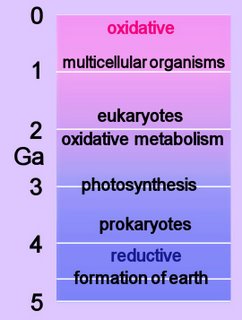timeline of life
 4.6 billion years ago the sun and planets condensed from a large, hot accretion disk.
4.6 billion years ago the sun and planets condensed from a large, hot accretion disk.Earth's earliest atmosphere of H2 and He was lost to space, and was replaced by a reductive atmosphere with a composition probably similar to outgassing of modern volcanoes – H2O, CO2, SO2, S2, Cl2, N2, NH3, and CH4.
Oxygen levels began to rise after the evolution of oxygenic photosynthesis by the Cyanobacteria, which evolved at least at least 3450 million years ago (3.45 Ga) and formed the earliest microfossils as stromatolite reefs.
Computer simulations that examine the effect of oxygen on metabolic networks demonstrate that many of the complex biochemical networks employed by advanced organisms could not have evolved without oxygen. The largest and most complex of these networks require the presence of molecular oxygen. Comparatively smaller, simpler networks encompass anoxic, or oxygen-free, pathways common to all life, from single-celled bacteria to the largest mammals. [n]
As Cyanobacteria poured oxygen into the early atmosphere, horizontal gene transfer probably enabled some prokaryotes to acquire oxygen-metabolizing machinery. There is considerable evidence that the earliest eukaryotes evolved through serial endosymbiosis. Chloroplasts resulted from endosymbiotic transfers of Cyanobacteria, and mitochondria originated from endosymbiotic transfers of alpha-proteobacteria (purple bacteria). Mitochondria are the site of oxidative phosporylation in eukaryotes.
αΩ Beginning αΩ Hadean αΩ abiogenesis αΩ LUCA αΩ phylogenetic tree αΩ evolution of oxygenic photosynthesis αΩ geological time αΩ timeline of life αΩ fossilization αΩ Ediacara Biota ▫ site map
tags [Evolution] [primordial atmosphere] [evolution of oxygenic atmosphere]
Labels: Cyanobacteria, early atmosphere, evolution of oxygenic photosynthesis, life timeline, stromatolites







































